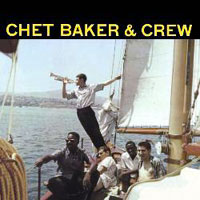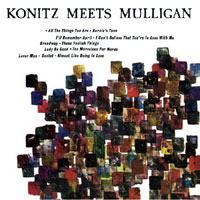Chet Baker • Chet Baker & Crew
Lee Konitz and Gerry Mulligan • Konitz Meets Mulligan
n 1952, when Pacific Jazz was founded in Los Angeles, New York was the epicenter of jazz recording. The Blue Note, Prestige, and Riverside labels were all headquartered in New York, and the three of them, along with music giant Columbia, which was also based in NYC, were responsible for the most important recordings of the era -- and the establishment of jazz as largely an East Coast phenomenon. But as its catalog grew, Pacific Jazz began to represent a different voice. Labeled variously West Coast or cool jazz, the records coming from Los Angeles were unlike those coming out of the East, even though some of Pacific Jazz's most prominent musicians paid their dues in New York. Trumpeter and vocalist Chet Baker was one of Pacific Jazz's most recognizable artists, but he attained even greater renown after leaving the label in the late 1950s. The eight tunes on the first LP of Chet Baker & Crew comprise the original album, with the second LP adding six more numbers that were recorded at the same time but not released. The swinging bop is in many ways quintessentially West Coast: a loping rhythmic foundation supports an overlay of well-arranged, melodic horns, the piano in a supporting role. Baker is characteristically pensive and lyrical -- like Bill Evans on trumpet -- and he has some taut interplay with Phil Urso on tenor sax. The early stereo sound is above average, featuring a well-resolved sense of space and ample center fill. The bass is also surprisingly punchy in spots. Alto saxophonist Lee Konitz is 83 and still making vital music -- he just released a live set recorded at the Village Vanguard. He was in his 20s when he "met" Gerry Mulligan, jazz's greatest baritonist and already an established star. Neither is a fiery soloist, preferring to purr instead of wail, and that works well as they trade licks on a group of standards, only one over four minutes long. Side one of Konitz Meets Mulligan was recorded in the studio, while side two was laid to tape at the Haig, the long-defunct jazz club off Wilshire Boulevard in Los Angeles. Except for a change in bassist, the lineup, which included Chet Baker, was the same for both sessions. The live material has the added charm of the audience, but there was obviously one microphone at the front of the stage for the soloist, so the other musicians sound softer and more distant. The studio session is far more even-handed in sonic terms and displays surprisingly distinct bass. The mono sound is nicely layered, though not as visceral as that of the most spectacular mono titles from Blue Note. The surfaces of both these LPs are impeccable -- as quiet
as vinyl gets. This helps reveal the personality of each recording all the better. Pure
Pleasure has released ten Pacific Jazz titles, but there are hundreds of the label's
recordings that are unrepresented among LP reissues. Here's hoping that Pure Pleasure
continues to mine this especially deep vein. |


